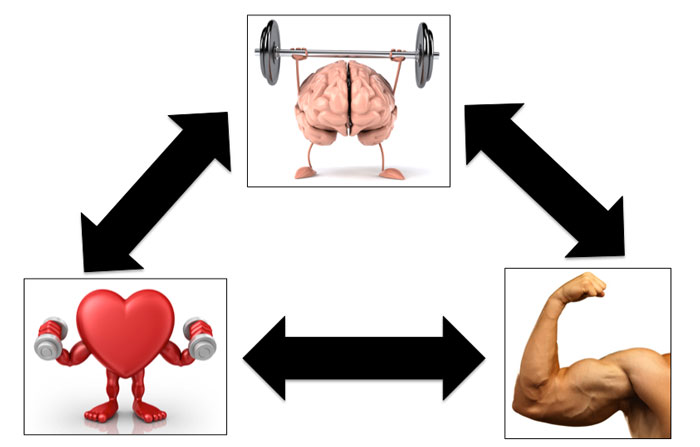
This is the fourth in a series of articles developed from Dr. Chris Hardy’s live presentation at Dragon Door’s Inaugural Health and Strength Conference. Click here to read the first article of the series.
In the previous posts of this series we were estimating the size of the stress cup. But, there’s a more reliable way to measure it. We’ll use the interrelationship of the brain, the cardiovascular system, and the musculo-skeletal system for another window into the stress cup. The first window is heart rate variability, the beat to beat variation of the heart rate.
We will use HRV as a window into the autonomic nervous system and how it relates to the heart. This will show us the stress load on a given day. On a high stress day, the sympathetic nervous system is dominant—the fight or flight system will drive the heart with a machine-like precision (low variability). This indicates a state of allostatic overload, poor health, and an overflowing stress cup.

Now, in the normal state—when you have good readiness and a manageable stress cup—you’re in parasympathetic dominance and will have that good, high variability.
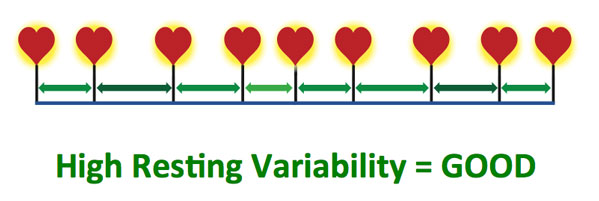
There are several apps that calculate HRV and will give you a score. There’s also a section in Strong Medicine that shows you how to do that in training. It’s a very simplistic approach, but its good for our purposes.
Joel Jamieson, a Seattle area MMA trainer uses HRV in training in a very sophisticated way so definitely look him up if you want to learn even more. But, I prefer a more simplistic and intuitive approach. But, before I show you my approach I want to quickly review another simple way to assess the state of the nervous system.
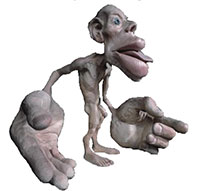 A homunculus is a representation of what we would look like if we were physically configured according to the proportion of brain required to operate our body parts. Do you see how big the hands are? A huge portion of the brain is involved with the sensation and motor control of the hands. For example, grip training has a huge impact on the nervous system. Grip strength is also a good way to tell the status of the nervous system. This idea has been used in the former Eastern bloc countries for a long time, and Charles Poliquin wrote about it pretty recently.
A homunculus is a representation of what we would look like if we were physically configured according to the proportion of brain required to operate our body parts. Do you see how big the hands are? A huge portion of the brain is involved with the sensation and motor control of the hands. For example, grip training has a huge impact on the nervous system. Grip strength is also a good way to tell the status of the nervous system. This idea has been used in the former Eastern bloc countries for a long time, and Charles Poliquin wrote about it pretty recently.
Charles Poliquin’s protocol starts with recording a baseline using a Dynamometer. You can get them pretty cheaply on Amazon. Be sure to measure grip strength in kilos when you (or your client, if you are training others) are feeling good. Then on the morning of training, measure it again, and if you drop 2kg, then you may want to reconsider training. If you drop 4kg from the baseline, then you might even consider taking a rest day. it’s a simple way to do it. Do you have to continually measure grip strength or HRV with all your clients? No, that would be ridiculous, fortunately there’s another method.
The Self-Rated Health Scale
In terms of predictors of who will develop chronic diseases, and who is at risk of dying, what is the best marker to use? We’ve used all kinds of blood tests, and every other imaginable test, but the best predictor we’ve found is to ask this one question:
“In general, would you say your health is on a one to five scale? With one being the best and five being the worst?”
Believe it or not, that self-rated health question was more accurate than any medical test in predicting if someone would develop a chronic disease in the next 5-10 years. There’s a new area of neuroscience intensely studying interoception, the brain’s subconscious awareness of our organ systems. Many of you who read Strong Medicine know that our gut and intestinal tract has just as many neurons and nerve cells as the spinal cord. Some even call it the “second brain”. When you have a gut feeling about something or butterflies in your stomach, that’s the brain actually monitoring the state of our organ systems on a subconscious level. It can also induce stress responses, which is why diabetics have an on-going low-level “fight or flight response” due to this interceptive process monitoring the state of the internal organs and immune system. The brain knows something bad is happening and that we need to be on alert. This system also gives you an intuitive sense of how you are doing.
A new study came out about HRV and focused on measuring what correlated best to Self-Rated Health. We already know the question predicts disease very well—they measured every blood test, cholesterol, inflammatory monitors, and many other tests, but what correlated best with Self-Graded Health was heart rate variability. People with high HRV (good) usually said that their health was about 4-5 on the scale (the highest health scores). So, how you intuitively feel physically and mentally is very predictive of your stress cup. This is why an intuitive approach to a given day’s training could be very valid. Even though there are some really sophisticated tools such as the Recovery Stress Questionnaire For Athletes—which is a validated tool—I guarantee that none of your clients will want to sit down and answer 76 questions.
If you’re training elite athletes, it’s great, but it is not practical for those of us in the trenches. My next suggestion is not validated, and I haven’t tried it out—so you can be the test group—what if we replaced the Self-Rated Health question with the following:
“In general, would you say your readiness to train is… excellent, very good, good, fair, or poor?”
I would also suggest verifying it by testing grip strength and heart rate variability first before asking the question to see how they correlate. Over time it will help them get an intuitive sense of how they are and fine tune their conscious awareness of interoception. So, when they give you a rating, you can also look at the data (grip strength and HRV), and over time this will be a pretty good window into how they’re doing.
Getting Your Clients Onboard with Smart Programming and Recovery
How do you convince your client that this stuff really matters? It’s essential. If you want to train hard, you’ve got to recover harder. You need to tell your clients that they need to reduce their stress cup and earn the ability to train hard. The results they want will only happen with a proper balance of training and recovery.
The first thing they have to fix is their sleep, and there’s a whole chapter in Strong Medicine about doing that. Stress management, meditation, yoga, whatever you want to do is fantastic. Massage and acupuncture are unbelievable for helping to reduce stress and enhance the parasympathetic nervous system. If you like qigong, tai chi, all that stuff is fantastic as well to achieve the same goal.
Obviously, cleaning up the nutrition is a whole lecture into itself. As is feeding your activity levels. If you are going to crush yourself with high intensity training, you need to replace that muscle glycogen. If you’re only doing a walking and strength-based program, you can go very low carb and be fine. But if you want to push that anaerobic threshold, then you will need to feed that activity or you will overtrain.
Summary:
First, estimate their stress cup size. Then, estimate what is filling it today, since it will be different that what fills it tomorrow. Then, we will prescribe an appropriate exercise volume and intensity—and that’s what you guys as trainers know how to do well already. Now, you have the extra information to help you adjust the sets and reps, intervals and modalities. And while you don’t have to assess the stress cup every time you train your clients, I think you should always ask the self-report scale question and then prescribe the appropriate amount of training.
I don’t think you need to use HRV on the average client. But, if you are working with elite athletes, you will need to cover all those bases. The most important thing for everyone is to always emphasize the importance of recovery.
Now, using this approach is very simple, and I provided the scientific foundation for how we came up with this very easy system. If you train someone this way, they will meet their goals. It will be sustainable, unlike those three or four weeks crash diets and radical exercise routines. With this method, every New Year, instead of starting over with a resolution, they can just continue building on the success of the previous year. This is just a framework, so use your expertise as a trainer to customize your programs.
The final post in this series will be the best of the question and answer portion of Dr. Chris Hardy’s presentation.
***
Chris Hardy, D.O., M.P.H., CSCS, is the author of Strong Medicine: How to Conquer Chronic Disease and Achieve Your Full Genetic Potential. He is a public-health physician, personal trainer, mountain biker, rock climber and guitarist. His passion is communicating science-based lifestyle information and recommendations in an easy-to-understand manner to empower the public in the fight against preventable chronic disease.
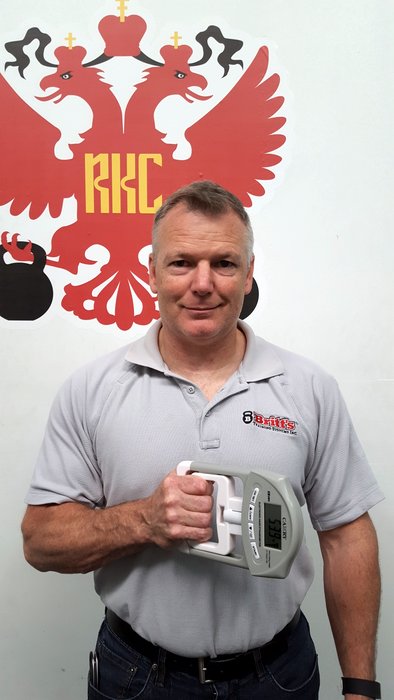
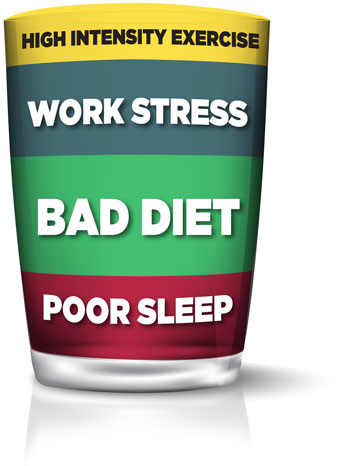 Dr. Hardy mentioned grip strength as a possible tool to measure the stress cup on a daily basis. There are studies that have shown that a decrease in grip strength is correlated with strokes, heart attacks and overall longevity—it made sense that it would also be an indicator of Central Nervous System health. I also liked the fact that it was a quick and easy check that I could do daily before I trained.
Dr. Hardy mentioned grip strength as a possible tool to measure the stress cup on a daily basis. There are studies that have shown that a decrease in grip strength is correlated with strokes, heart attacks and overall longevity—it made sense that it would also be an indicator of Central Nervous System health. I also liked the fact that it was a quick and easy check that I could do daily before I trained.